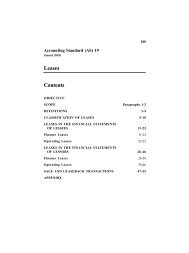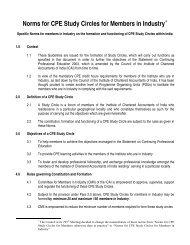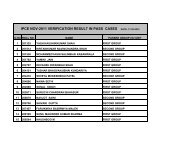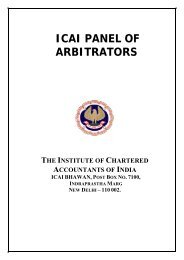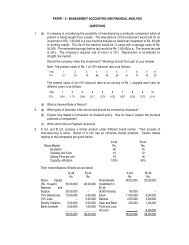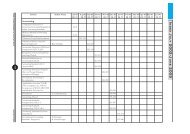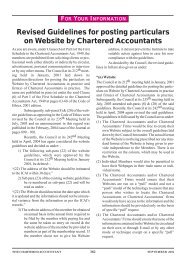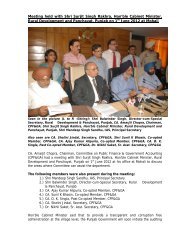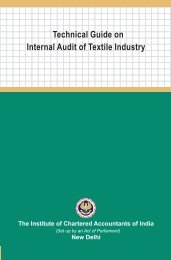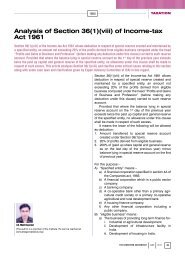The Chartered Accountant
The Chartered Accountant
The Chartered Accountant
Create successful ePaper yourself
Turn your PDF publications into a flip-book with our unique Google optimized e-Paper software.
communications will vary with the<br />
circumstances of the engagement.<br />
Relevant circumstances include the<br />
significance and nature of the matter,<br />
and the action expected to be taken by<br />
those charged with governance. For<br />
example:<br />
l Communications regarding<br />
l<br />
planning matters may often be<br />
made early in the audit engagement<br />
and, for an initial engagement,<br />
may be made as part of<br />
agreeing the terms of the engagement.<br />
It may be appropriate to communicate<br />
a significant difficulty<br />
encountered during the audit<br />
as soon as practicable if those<br />
charged with governance are<br />
able to assist the auditor to<br />
overcome the difficulty, or if<br />
it is likely to lead to a modified<br />
opinion.<br />
l Similarly, it may be appropriate<br />
to communicate material weaknesses<br />
in the design, implementation<br />
or operating effectiveness<br />
of internal control that have<br />
come to the auditor’s attention<br />
as soon as practicable.<br />
l Communications regarding independence<br />
may be appropriate<br />
whenever significant judgments<br />
are made about threats to independence<br />
and related safeguards,<br />
for example, when accepting an<br />
engagement to provide non-audit<br />
services, and at a concluding<br />
discussion. A concluding discussion<br />
may also be an appropriate<br />
time to communicate findings<br />
from the audit, including the<br />
auditor’s views about the qualitative<br />
aspects of the entity’s accounting<br />
practices.<br />
l When auditing both general<br />
purpose and special purpose<br />
financial statements, it may be<br />
appropriate to co-ordinate the<br />
timing of communications.<br />
A45. Other factors that may be relevant<br />
to the timing of communications<br />
include:<br />
STANDARDS<br />
l <strong>The</strong> size, operating structure, control<br />
environment, and legal structure<br />
of the entity being audited.<br />
l Any legal obligation to communicate<br />
certain matters within a<br />
specified timeframe.<br />
l <strong>The</strong> expectations of those<br />
charged with governance, including<br />
arrangements made for<br />
periodic meetings or communications<br />
with the auditor.<br />
l <strong>The</strong> time at which the auditor<br />
identifies certain matters, for<br />
example, the auditor may not<br />
identify a particular matter (e.g.,<br />
non-compliance with a law) in<br />
time for preventive action to be<br />
taken, but communication of<br />
the matter may enable remedial<br />
action to be taken.<br />
Adequacy of the Communication<br />
Process (Ref: Para. 18)<br />
A46. <strong>The</strong> auditor need not design<br />
specific procedures to support the<br />
evaluation of the two-way communication<br />
between the auditor and those<br />
charged with governance; rather, that<br />
evaluation may be based on observations<br />
resulting from audit procedures<br />
performed for other purposes. Such<br />
observations may include:<br />
l <strong>The</strong> appropriateness and timeliness<br />
of actions taken by those<br />
charged with governance in response<br />
to matters raised by the<br />
auditor. Where significant matters<br />
raised in previous communications<br />
have not been dealt<br />
with effectively, it may be appropriate<br />
for the auditor to inquire<br />
as to why appropriate action<br />
has not been taken, and to<br />
consider raising the point again.<br />
This avoids the risk of giving<br />
an impression that the auditor<br />
is satisfied that the matter has<br />
been adequately addressed or is<br />
no longer significant.<br />
l <strong>The</strong> apparent openness of<br />
those charged with governance<br />
in their communications with<br />
the auditor.<br />
13 SA 315, “ Understanding the Entity and Its Environment and Assessing the Risks of Material Misstatement”, paragraph A66.<br />
l <strong>The</strong> willingness and capacity of<br />
those charged with governance<br />
to meet with the auditor without<br />
management present.<br />
l <strong>The</strong> apparent ability of those<br />
charged with governance to fully<br />
comprehend matters raised<br />
by the auditor, for example, the<br />
extent to which those charged<br />
with governance probe issues,<br />
and question recommendations<br />
made to them.<br />
l Difficulty in establishing with<br />
those charged with governance<br />
a mutual understanding of the<br />
form, timing and expected general<br />
content of communications.<br />
l Where all or some of those<br />
charged with governance are<br />
involved in managing the entity,<br />
their apparent awareness<br />
of how matters discussed with<br />
the auditor affect their broader<br />
governance responsibilities, as<br />
well as their management responsibilities.<br />
l Whether the two-way communication<br />
between the auditor<br />
and those charged with governance<br />
meets applicable legal<br />
and regulatory requirements.<br />
A47. As noted in paragraph A1, effective<br />
two-way communication assists<br />
both the auditor and those<br />
charged with governance. Further,<br />
SA 315 identifies participation by<br />
those charged with governance, including<br />
their interaction with internal<br />
audit, if any, and external auditors,<br />
as an element of the entity’s control<br />
environment. 13 Inadequate two-way<br />
communication may indicate an unsatisfactory<br />
control environment and<br />
influence the auditor’s assessment of<br />
the risks of material misstatements.<br />
<strong>The</strong>re is also a risk that the auditor<br />
may not have obtained sufficient appropriate<br />
audit evidence to form an<br />
opinion on the financial statements.<br />
A48. If the two-way communication<br />
between the auditor and those charged<br />
THE CHARTERED ACCOUNTANT 1099 DECEMBER 2008



